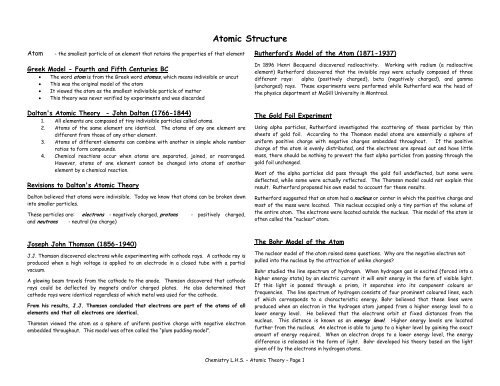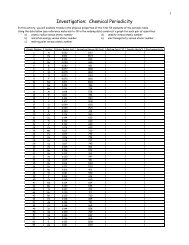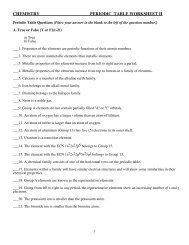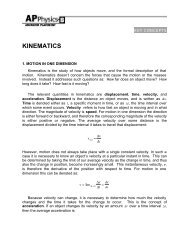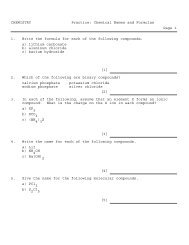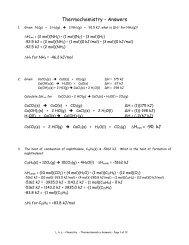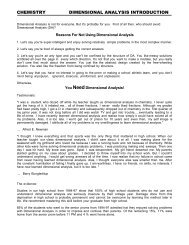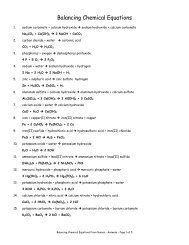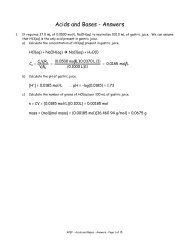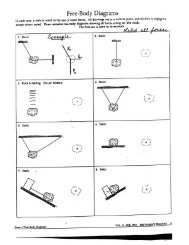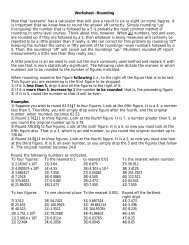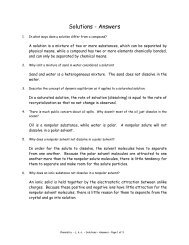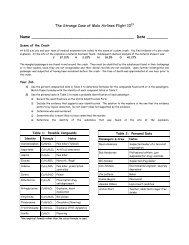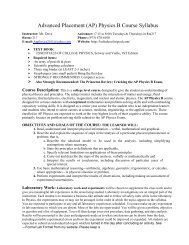Create successful ePaper yourself
Turn your PDF publications into a flip-book with our unique Google optimized e-Paper software.
<strong>Atomic</strong> <strong>Structure</strong>Atom- the smallest particle of an element that retains the properties of that elementRutherford’s Model of the Atom (1871-1937)Greek Model - Fourth and Fifth Centuries BC• The word atom is from the Greek word atomos, which means indivisible or uncut• This was the original model of the atom• It viewed the atom as the smallest indivisible particle of matter• This theory was never verified by experiments and was discardedDalton's <strong>Atomic</strong> Theory - John Dalton (1766-1844)1. All elements are composed of tiny indivisible particles called atoms.2. Atoms of the same element are identical. The atoms of any one element aredifferent from those of any other element.3. Atoms of different elements can combine with another in simple whole numberratios to form compounds.4. Chemical reactions occur when atoms are separated, joined, or rearranged.However, atoms of one element cannot be changed into atoms of anotherelement by a chemical reaction.Revisions to Dalton's <strong>Atomic</strong> TheoryDalton believed that atoms were indivisible. Today we know that atoms can be broken downinto smaller particles.These particles are: electrons - negatively charged, protons - positively charged,and neutrons - neutral (no charge)In 1896 Henri Becquerel discovered radioactivity. Working with radium (a radioactiveelement) Rutherford discovered that the invisible rays were actually composed of threedifferent rays: alpha (positively charged), beta (negatively charged), and gamma(uncharged) rays. These experiments were performed while Rutherford was the head ofthe physics department at McGill University in Montreal.The Gold Foil ExperimentUsing alpha particles, Rutherford investigated the scattering of these particles by thinsheets of gold foil. According to the Thomson model atoms are essentially a sphere ofuniform positive charge with negative charges embedded throughout. If the positivecharge of the atom is evenly distributed, and the electrons are spread out and have littlemass, there should be nothing to prevent the fast alpha particles from passing through thegold foil unchanged.Most of the alpha particles did pass through the gold foil undeflected, but some weredeflected, while some were actually reflected. The Thomson model could not explain thisresult. Rutherford proposed his own model to account for these results.Rutherford suggested that an atom had a nucleus or center in which the positive charge andmost of the mass were located. This nucleus occupied only a tiny portion of the volume ofthe entire atom. The electrons were located outside the nucleus. This model of the atom isoften called the “nuclear” atom.Joseph John Thomson (1856-1940)J.J. Thomson discovered electrons while experimenting with cathode rays. A cathode ray isproduced when a high voltage is applied to an electrode in a closed tube with a partialvacuum.A glowing beam travels from the cathode to the anode. Thomson discovered that cathoderays could be deflected by magnets and/or charged plates. He also determined thatcathode rays were identical regardless of which metal was used for the cathode.From his results, J.J. Thomson concluded that electrons are part of the atoms of allelements and that all electrons are identical.Thomson viewed the atom as a sphere of uniform positive charge with negative electronembedded throughout. This model was often called the “plum pudding model”.The Bohr Model of the AtomThe nuclear model of the atom raised some questions. Why are the negative electron notpulled into the nucleus by the attraction of unlike charges?Bohr studied the line spectrum of hydrogen. When hydrogen gas is excited (forced into ahigher energy state) by an electric current it will emit energy in the form of visible light.If this light is passed through a prism, it separates into its component colours orfrequencies. The line spectrum of hydrogen consists of four prominent coloured lines, eachof which corresponds to a characteristic energy. Bohr believed that these lines wereproduced when an electron in the hydrogen atom jumped from a higher energy level to alower energy level. He believed that the electrons orbit at fixed distances from thenucleus. This distance is known as an energy level. Higher energy levels are locatedfurther from the nucleus. An electron is able to jump to a higher level by gaining the exactamount of energy required. When an electron drops to a lower energy level, the energydifference is released in the form of light. Bohr developed his theory based on the lightgiven off by the electrons in hydrogen atoms.Chemistry L.H.S. – <strong>Atomic</strong> Theory – Page 1
The Quantum Mechanical Model of the AtomHow Electrons are Arranged in AtomsBohr's model of the atom worked very well with hydrogen, which has only one electron peratom, however, problems arose when it was applied to atoms with more than one electron.Erwin Schrödinger developed a mathematical equation describing the location and energy ofthe electrons in atoms. This equation works for hydrogen as well as atoms with more thanone electron.Similar to the Bohr model, the quantum mechanical model also places electrons in energylevels. It is different in the following ways:Aufbau Principle: Electrons fill the lowest energy level orbitals first beforeentering higher energy orbitals.Pauli Exclusion Principle: An atomic orbital may contain zero, one, or twoelectrons. If two electrons occupy the same orbital, they must have opposite spin.Hund's Rule: When electrons enter orbitals of equal energy, each electronenters a separate orbital until all orbitals at the same energy are half full beforeany electrons pair up in the same orbital.The exact path of the electron cannot be defined, only the probability of the electron'slocation. This is described as an electron cloud. The electron can be found anywhere withinthe cloud, but is most likely to be found where the cloud is mostdense.Within energy levels, there are sublevels called orbitals. At higherenergy levels there are more than one type of orbital.Energy Levels, Orbitals, and Electronsn = energy level• the 1st energy level has 1 type of orbital (s)• the 2nd energy level has 2 types of orbitals (s, & p)• the 3rd energy level has 3 types of orbitals (s, p, & d)• the 4th energy level has 4 types of orbitals (s, p, d, & f)• At each energy level there is only one s orbital.• At the second energy level and higher, there are three porbitals.• At the third energy level and higher, there are five dorbitals.• At the fourth energy level and higher, there are seven forbitals.Electron Configurations - describes how the electrons arearranged in the atom.Diagonal RuleEnergy Level Diagram – a diagram that illustrates how electrons are arranged in the atom.1s2s2p3s 3p 3d4s 4p 4d 4f5s 5p 5d 5f6s 6p 6d 6fDiagonal Rule - Shows the order in which electrons enter orbitals.- Shows how energy levels overlap.Quantum NumbersThe Schrödinger equation is the central equation of the quantum theory.This equation correctly predicts the properties of multielectron atomsand molecules. When the Schrödinger equation is solved, we find thatthe energy of an electron is restricted to a discrete set of values, as inthe Bohr theory; however, they differ in their description of thelocation of the electrons. Instead of restricting the electron to certain,sharp orbits, the Schrödinger equation provides one or more wavefunctions or orbitals associated with each allowed energy. The square ofthe wave function is a probability density. This represents the regionwhere the probability of finding an electron is the greatest.Each electron in an atom can be identified by its own set of four quantumnumbers.Principal Quantum Number (n) corresponds to the energy levels(1,2,3, …)7s 7p 7d 7fAzimuthal Quantum Number (l) specifies the shape of an orbital. l isrestricted to the values 0, 1, … , n-1. For historical reasons, the values ofl are designated by letters: 0 = s, 1 = p, 2= d, 3 = f, … The letters s, p, d,and f, stand for sharp, principal, diffuse, and fundamental, for l = 4 andgreater, the letters follow alphabetical order after f.Magnetic Quantum Number (m) determines the spatial orientation of an orbital. m isrestricted to values from l to –l.Energy Level Population – states the number of electrons present at each energy level in anatom.Spin Quantum Number (s) An electron spins like a top in one of two directions about itsaxis. The spin state of an electron can have one of two possible values: ½ or -½.Chemistry L.H.S. – <strong>Atomic</strong> Theory – Page 2


